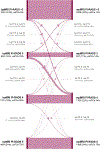Evaluating Biparametric Versus Multiparametric Magnetic Resonance Imaging for Diagnosing Clinically Significant Prostate Cancer: An International, Paired, Noninferiority, Confirmatory Observer Study
- PMID: 39438187
- PMCID: PMC11769734
- DOI: 10.1016/j.eururo.2024.09.035
Evaluating Biparametric Versus Multiparametric Magnetic Resonance Imaging for Diagnosing Clinically Significant Prostate Cancer: An International, Paired, Noninferiority, Confirmatory Observer Study
Abstract
Background and objective: Biparametric magnetic resonance imaging (bpMRI), excluding dynamic contrast-enhanced (DCE) magnetic resonance imaging (MRI), is a potential replacement for multiparametric MRI (mpMRI) in diagnosing clinically significant prostate cancer (csPCa). An extensive international multireader multicase observer study was conducted to assess the noninferiority of bpMRI to mpMRI in csPCa diagnosis.
Methods: An observer study was conducted with 400 mpMRI examinations from four European centers, excluding examinations with prior prostate treatment or csPCa (Gleason grade [GG] ≥2) findings. Readers assessed bpMRI and mpMRI sequentially, assigning lesion-specific Prostate Imaging Reporting and Data System (PI-RADS) scores (3-5) and a patient-level suspicion score (0-100). The noninferiority of patient-level bpMRI versus mpMRI csPCa diagnosis was evaluated using the area under the receiver operating curve (AUROC) alongside the sensitivity and specificity at PI-RADS ≥3 with a 5% margin. The secondary outcomes included insignificant prostate cancer (GG1) diagnosis, diagnostic evaluations at alternative risk thresholds, decision curve analyses (DCAs), and subgroup analyses considering reader expertise. Histopathology and ≥3 yr of follow-up were used for the reference standard.
Key findings and limitations: Sixty-two readers (45 centers and 20 countries) participated. The prevalence of csPCa was 33% (133/400); bpMRI and mpMRI showed similar AUROC values of 0.853 (95% confidence interval [CI], 0.819-0.887) and 0.859 (95% CI, 0.826-0.893), respectively, with a noninferior difference of -0.6% (95% CI, -1.2% to 0.1%, p < 0.001). At PI-RADS ≥3, bpMRI and mpMRI had sensitivities of 88.6% (95% CI, 84.8-92.3%) and 89.4% (95% CI, 85.8-93.1%), respectively, with a noninferior difference of -0.9% (95% CI, -1.7% to 0.0%, p < 0.001), and specificities of 58.6% (95% CI, 52.3-63.1%) and 57.7% (95% CI, 52.3-63.1%), respectively, with a noninferior difference of 0.9% (95% CI, 0.0-1.8%, p < 0.001). At alternative risk thresholds, mpMRI increased sensitivity at the expense of reduced specificity. DCA demonstrated the highest net benefit for an mpMRI pathway in cancer-averse scenarios, whereas a bpMRI pathway showed greater benefit for biopsy-averse scenarios. A subgroup analysis indicated limited additional benefit of DCE MRI for nonexperts. Limitations included that biopsies were conducted based on mpMRI imaging, and reading was performed in a sequential order.
Conclusions and clinical implications: It has been found that bpMRI is noninferior to mpMRI in csPCa diagnosis at AUROC, along with the sensitivity and specificity at PI-RADS ≥3, showing its value in individuals without prior csPCa findings and prostate treatment. Additional randomized prospective studies are required to investigate the generalizability of outcomes.
Keywords: Biparametric magnetic resonance imaging; Dynamic contrast-enhanced imaging; Multiparametric magnetic resonance imaging; Noninferiority; Observer study; Prostate cancer.
Copyright © 2024 The Authors. Published by Elsevier B.V. All rights reserved.
Figures


References
-
- Rouvière O, Puech P, Renard-Penna R, et al. Use of prostate systematic and targeted biopsy on the basis of multiparametric MRI in biopsy-naive patients (MRI-FIRST): a prospective, multicentre, paired diagnostic study. Lancet Oncol 2019;20:100–9. - PubMed
-
- van der Leest M, Cornel E, Israël B, et al. Head-to-head comparison of transrectal ultrasound-guided prostate biopsy versus multiparametric prostate resonance imaging with subsequent magnetic resonance-guided biopsy in biopsy-naïve men with elevated prostate-specific antigen: a large prospective multicenter clinical study. Eur Urol 2019;75:579–81. - PubMed
-
- Cornford P, van den Bergh RCN, Briers E, et al. EAU-EANM-ESTRO-ESUR-ISUP-SIOG guidelines on prostate cancer—2024 update. Part I: screening, diagnosis, and local treatment with curative intent. Eur Urol 2024;86:148–63. - PubMed
Publication types
MeSH terms
Grants and funding
LinkOut - more resources
Full Text Sources
Medical
Research Materials
Miscellaneous

